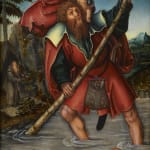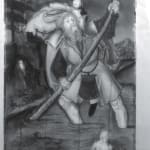
Infrared reflectography of the panel showing
Cranach's underdrawing, with various pentiments.
Lucas Cranach the Elder (Kronach 1472 - 1553 Weimar) and studio
Lucas Cranach the Elder was one of the most important artists of the German Renaissance. He embodied the idea of the Renaissance man, active not only as a painter and printmaker, but also as a successful entrepreneur and politician. Born in the Franconian town of Kronach, from which he took his name, Cranach is first documented to be active as a fully-fledged artist in Vienna in 1502, following a period of apprenticeship, which remains rather obscure. In 1505, he was called to Wittenberg to become court painter to Duke Frederick the Wise, Elector of Saxony, supplying paintings, murals and decorations for the various ducal residences at Wittenberg, Veste Coburg, Torgau and elsewhere. Thanks to the speed, efficiency and invention with which he worked, Cranach became one of the most sought-after artists of his time, heading a large workshop that included his sons Hans (ca. 1513–1537) and Lucas the Younger (1515–1586), as well as numerous apprentices. He executed paintings of different genres, made engravings on copper, and drew designs for coins produced by the electoral mint. He also owned a press on which he printed his engravings. Following the death of Frederick the Wise in 1525, Cranach continued to work for his successors William and John, before passing away in Weimar in 1553.
A friend of Martin Luther, who lived and taught in Wittenberg under the protection of the Electors of Saxony, Cranach often engaged in depictions of religious themes. The subject of the present work is the story of Saint Christopher, the patron saints of travellers, which was enormously popular all- over Northern Europe from the fourteenth century onwards. Images were widely spread, because they were believed to prevent the onlooker from sudden death on the same day. According to the Golden Legend, Christopher was a hulking Canaanite man, originally called Reprobus, who desired to serve the best king there was. During his wanderings in search of the all-powerful Christ, he came upon a hermit who told him that, because of his size and strength, he should have served the Lord by carrying people across an otherwise unfordable river. One day, a child approached Saint Christopher by the river and asked to be helped across. As Christopher started to carry him, the child got heavier and heavier, and the flow stronger and stronger. After eventually reaching the opposite shore, the child revealed himself to be Christ, telling Christopher that, by carrying him, he had just carried the weight of the world. From that moment on, Reprobus was renamed Christophoros, which, in Greek, means "the Christ-bearer".
In the present work, Cranach depicted the story of Christopher according to its traditional iconography. The saint is represented as a giant man with unkempt, curly hair and beard, dressed in a red tunic with dark blue sleeves underneath, and a blue and white collar, wearing a sword and a saddlebag on his belt. As is traditional in depictions of the saint, Christopher fords the river using a large staff – one of his identifying attributes – which bends under the weight of Christ Child. This sits on the saint’s left shoulder, holding an orb in one hand, and giving his blessing with his other hand. The scene is set in a fantastic, rocky landscape, where other figures appear. In the left part of the picture, standing on the bank of the river, is the hermit, who had instructed Christopher in the Christian faith. In the lower foreground is a monstrous fish swimming in the river, chasing after a nude young woman, possibly a nymph or a mermaid.
According to M. J. Friedländer and J. Rosenberg, Cranach painted Saint Christopher with the Christ child crossing a stream in circa 1518-1520, when he was already an artist in high demand. Around the same time, he painted two other works of the same subject, which are today in the collections of the Detroit Institute of Arts (1518-1520) and the Cummer Museum of Art & Gardens. Despite some variations, the three paintings share a very similar composition. They all include the detail of the nymph/mermaid, which is Cranach’s personal addition to the story, possibly symbolising temptation, while the fish might be a symbol of danger. Cranach depicted the story of Saint Christopher also on other occasions, on the lateral wings of polyptychs, as exemplified by a panel in the Museo Thyssen-Bornemisza, where the figures are depicted against a dark background, and in another from a private collection. He also addressed the theme in printmaking, in a popular woodcut of which examples can be found in the Metropolitan Museum of Art and the Washington National Gallery.
The repetition of comparable compositions was a distinctive element of the Renaissance workshop, including Cranach’s, in which successful images were repeated to be sold on the open market. When the present painting was offered at auction in 2008, Ludwig Meyer pointed out that the composition was developed by the master, while much of the painted surface was likely executed by assistants. Specifically, Cranach probably began the head and collar of Saint Christopher, and continued with the figure of the Christ Child with his billowing cape. Meyer explained that “the part of the shoulder is very well painted and shows great plasticity that only Cranach was able to do. The head of Saint Christopher has great power and the Child is good and quite humorous.” He added that the artist probably also made a rendering of the rest of the figure in order to give the workshop’s assistants an impression of the whole composition. On the occasion of the sale, Dr. Dieter Koepplin agreed with Meyer that the panel is a collaborative effort between the artist and his workshop.
Infrared reflectography of the present panel (see ill.) has revealed bold and vigorous underdrawing denoting freehand application, with almost all aspects of the drawn design shifted and adjusted at the painting stage. The Christ Child, whose right hand is raised in blessing, was originally conceived with his hand outstretched – as in the Cummer and the Detroit paintings – and his smaller head encircled with a different halo design. Likewise, the nymph in the water is drawn with more contrapposto, with a tilted head, and more exaggerated breasts. These changes all indicate a considerable degree of freedom and spontaneity on the part of the artist and the design process. The freehand drawing, with its strokes of varied width and intensity that suggest the use of a pointed brush, is very close to that seen in the London National Gallery's reflectograms of the heads of the Saints Christina and Ottilia panel.
Infrared reflectography of the National Gallery panels also reveals numerous minor changes between the painted composition and the drawing, which is only used as a general guide. Unlike some more complex, figurative panels given to the artist, drawing here is mostly confined to linear outlines and there is little or no use of washes and hatching strokes. Equivalent linear, freehand drawing with an absence of washes and hatching is present in many of Cranach's broadly contemporary works, such as the Stigmatisation of Saint Francis from circa 1510–1515 in the Germanisches Nationalmuseum, Nuremberg, and other simpler compositions, such as the Adam and Eve panels from circa 1508–1510 in the Musée des Beaux-Arts et d'Archéologie, Besançon. However, some of the drawing marks outlining the design are so broad that they arealmost wash-like, such as in Saint Christopher's left leg. Heydenreich's research has found that Cranach integrated his underdrawing efficiently in the painting process by using broad, linear underdrawing in the shadows, which appears to be a technique employed in the present work.
Provenance
Pastor Adolf Glitza, Hamburg, 1893.
Mrs Meyer-Glitza, Hamburg, 1932;
Anonymous sale, Berlin, Graupe, 10 December 1932, lot 96;
By descent until sale, Christie's, Amsterdam, 10 November 2008, lot 124, where acquired post-sale by a private collector;
Sale, Sotheby’s, London, 29 July 2020, lot 108, where acquired by the present owner.
Exhibitions
London, Greenwich, The Queen's House, National Maritime Museum (on loan October 2018 – December 2019).
Literature
M. J. Friedländer and J. Rosenberg, Die Gemälde von Lucas Cranach, Berlin 1932, p. 48, cat. no. 96, reproduced (as Cranach the Elder).
M. J. Friedländer and J. Rosenberg, The Paintings of Lucas Cranach, London 1978, p. 91, cat. no. 109, illustrated (as Cranach the Elder, circa 1518–1520).
K. Chamonikola, Pod znamením okrídleného hada. Lucas Cranach a ceské zeme, exh. cat., Prague 2005, p. 110, under cat. no. 27.
Cranach Digital Archive (as Cranach the Elder).


